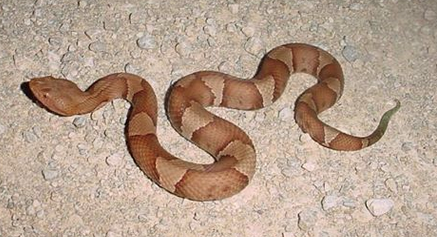The odds of the “average” person being bitten by a rattlesnake is low— that is, if you’re an “average” city dweller or someone who doesn’t hike, hunt, or work around timber. But what if you spend a great deal of time outdoors in known snake country either working or playing or both? Then you might want to take the threat of snakebite seriously and protect yourself with rattlesnake gaiters or by wearing snake proof boots. The Centers for Disease Control and Prevention report that 7,000 - 8,000 venomous snakebites occur per year in the United States. If you like statistics, here are a few more:
• 55% of people bitten by snakes are male, ages 17 to 27.
• 28% of snakebite victims were intoxicated.
• 50% of bites occur on the feet and legs; 50% are to the fingers and hands.
• 57% of snakebite victims were handling the snake at the time of the bite.
A triangular shaped head and cat-like eyes are  giveaways that a snake is venomous. Non-venomous snakes have round heads and round pupils. Venomous snakes will normally be heavier and fatter, too. The Western Diamondback, also called the Pacific Western Rattlesnake, is one of the most common member of the viper family. A common myth about any species of rattlesnake is that they are vicious and go around looking for someone to bite. The fact is that most actually only strike in self-defense or to obtain food. Self-defense includes when they are startled, and that’s exactly when the “average” person is bitten— when they accidentally step on or near a viper, or are working in tall weeds or around wood piles. When not basking out in the sun, most of a snake’s time is spent hiding under a rock or a bush. If you have ever hiked through the woods, chances are you have passed within a foot or so from a rattler and luckily never knew it.
giveaways that a snake is venomous. Non-venomous snakes have round heads and round pupils. Venomous snakes will normally be heavier and fatter, too. The Western Diamondback, also called the Pacific Western Rattlesnake, is one of the most common member of the viper family. A common myth about any species of rattlesnake is that they are vicious and go around looking for someone to bite. The fact is that most actually only strike in self-defense or to obtain food. Self-defense includes when they are startled, and that’s exactly when the “average” person is bitten— when they accidentally step on or near a viper, or are working in tall weeds or around wood piles. When not basking out in the sun, most of a snake’s time is spent hiding under a rock or a bush. If you have ever hiked through the woods, chances are you have passed within a foot or so from a rattler and luckily never knew it.
Make no mistake, a bite from a rattler (or copperhead or water moccasin, etc.) can be very serious business. Their venom breaks down the tissue around the bite. When a rattlesnake bites its prey, this action of breaking down the tissue hastens the digestive process and makes it easier for the snake to swallow its prey. If a human is bitten, there is often a loss of tissue around the bite. The snake’s teeth also transfer bacteria and the venom suppresses the immune system of the victim, making it tougher to fight off infection. While this rarely causes death, it can result in the loss of a limb. And the entire process is extremely painful and can be expensive due to the cost of anti-venom.
So why take a chance? If you spend a good amount of time where snakes live, protect yourself by wearing snake proof gaiters or snake proof boots. Luckily, Razer snake gaiters for women and snake gaiters for men are the same product. Children are bitten more frequently than adults. Most children are bitten because they often go barefoot or actually pick up a rattlesnake out of curiosity. Make sure the kids are wearing snake chaps sized just for them.
And if you are bitten, keep in mind that all that stuff about tourniquets, cutting open bites, or trying to suck out the venom has been disavowed by current medical thinking. Don’t apply ice to the wound either. Instead, the advice is simply to seek medical treatment immediately. If you’re a long way from that, try to keep your heart rate down and the bite location below the level of your heart. Your best snakebite kit is your cellphone or your car keys! And although it might be counter-intuitive, avoid killing snakes since they are valuable to our ecosystem. Plus, in many states, illegally killing a snake is a misdemeanor punishable by a fine and/or jail time.